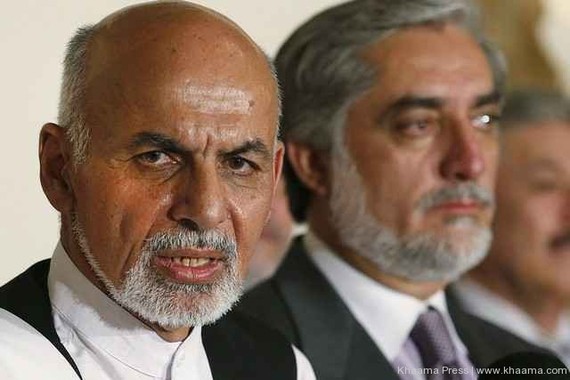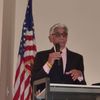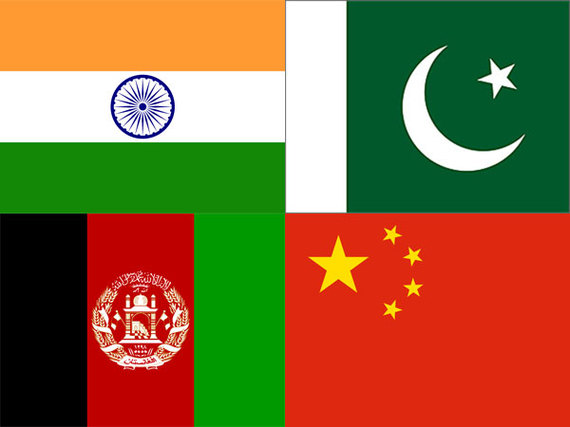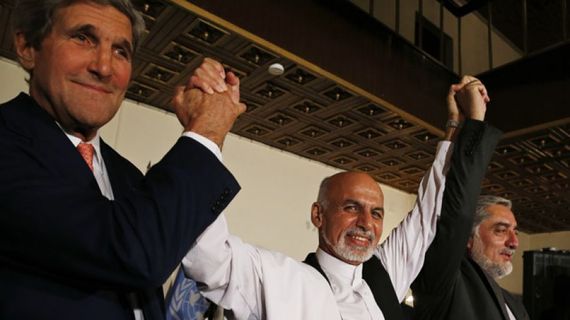Afghanistan, also known as the crossroads of civilization dating back centuries, has found itself on a different crossroad in the past few decades. This time around, however, it has been very deadly and destructive for Afghanistan and its inhabitants. Afghanistan's geographical situation in south central Asia as a land locked country is partially responsible for its woes. It can be viewed as a corridor connecting south Asia to central Asia and west Asia to east Asia.
As China to the east and India to the south have emerged as major world powers, their presence and competition for resources greatly affect the region as well. Afghanistan has enormous untapped mineral riches making it attractive to both India and China. Both countries need raw materials for their continued growth and domination.
Nuclear-armed Pakistan, which has fought wars with an economically and militarily stronger India, sees its interests in jeopardy due to increasing Indian influence in Afghanistan. Therefore, Pakistan continues to provide safe havens for and support the Taliban. Their aim is to keep Afghanistan destabilized and thus limit Indian influence. Pakistan also wants to control Afghanistan's future with a friendly government, again, to counter India.
The animosity between Pakistan and India has created an atmosphere of complete distrust adversely affecting Afghanistan. Any move by either country is deemed suspicious by the other, requiring a response to counter it. This tit for tat policy seems to be spiraling out of control with no end in sight in the near future.
Until the late 1970s, Afghanistan managed to stay out of the regional conflicts by adopting a non-aligned foreign policy. Since Afghanistan was a viable nation state capable of defending itself, Pakistan was not able to destabilize Afghanistan indirectly or directly by proxy. But the Soviet invasion and the subsequent civil war did away with the legitimate government of Afghanistan. It furthermore destroyed the foundation it was built on, paving the way for chaos. Pakistan took advantage of this situation to prop up the Taliban in the 1990s as a proxy to control Afghanistan.
Internal Afghan politics is a major complicating factor also. Weak, dysfunctional and warlord-dominated Afghan governments that the U.S. has supported since 2002 have caused disaffection among some Afghans, which the Taliban and Pakistan exploit. Both Karzai's regime and the current National Unity Government (NUG) are controlled by the warlords. These warlords were responsible for the Afghan civil war in the early 1990s following the Soviet defeat.
NUG, headed by Afghan President Ashraf Ghani, who was forced into a power-sharing arrangement with Abdullah Abdullah as the Chief Executive Officer, was established in September 2014. Its mandate is about to come to an end and there are uncertainties about its future. Ghani and Abdullah never saw eye to eye. The situation between the two men has become so acrimonious that Abdullah recently called Ghani unfit for the president's office. This is not surprising given how precariously NUG came into existence.
 Afghan Pres. Ghani and CEO Abdullah Avoiding Eye Contact (Photo: khaama.com) Mr. Ghani is an ethnic Pashtun, the largest ethnic group in Afghanistan. He had to ally himself with Rasheed Dostom, a notorious Uzbek warlord from the north, to compensate for a shortfall of Pashtun votes. If Afghanistan is divided along ethnic and tribal fault lines and if the Pashtuns are the largest group, why did Ashraf Ghani need Dostom's support? The reason is that many Pashtuns believe that they have been marginalized and that the international community's intervention in Afghanistan conspired with the Northern Alliance against them. The Taliban are mostly Pashtuns. The Northern Alliance is mostly Tajik, but at times is in an uneasy coalition with Uzbeks and Hazaras as well. As a result, a good number of Pashtuns do not participate in the electoral process, which is also grossly flawed. The presidential election of 2014 was mired by accusations of fraud, with both Ghani and Abdullah pointing fingers at each other. Abdullah went so far as to threaten the stability of the government. To prevent a potentially serious situation the US Secretary of State John Kerry repeatedly intervened to bring the warring parties together. The result was the formation of the so called National Unity Government which recognized Mr. Ghani as the president and appointed Mr. Abdullah as the chief executive, a position which does not exist in the country's constitution.
Afghan Pres. Ghani and CEO Abdullah Avoiding Eye Contact (Photo: khaama.com) Mr. Ghani is an ethnic Pashtun, the largest ethnic group in Afghanistan. He had to ally himself with Rasheed Dostom, a notorious Uzbek warlord from the north, to compensate for a shortfall of Pashtun votes. If Afghanistan is divided along ethnic and tribal fault lines and if the Pashtuns are the largest group, why did Ashraf Ghani need Dostom's support? The reason is that many Pashtuns believe that they have been marginalized and that the international community's intervention in Afghanistan conspired with the Northern Alliance against them. The Taliban are mostly Pashtuns. The Northern Alliance is mostly Tajik, but at times is in an uneasy coalition with Uzbeks and Hazaras as well. As a result, a good number of Pashtuns do not participate in the electoral process, which is also grossly flawed. The presidential election of 2014 was mired by accusations of fraud, with both Ghani and Abdullah pointing fingers at each other. Abdullah went so far as to threaten the stability of the government. To prevent a potentially serious situation the US Secretary of State John Kerry repeatedly intervened to bring the warring parties together. The result was the formation of the so called National Unity Government which recognized Mr. Ghani as the president and appointed Mr. Abdullah as the chief executive, a position which does not exist in the country's constitution.
The NUG made promises about curbing corruption, ending the culture of impunity, improving the security situation and so on, but the result thus far has been dismal at best. NUG's failures combined with its political infighting compounds the challenges of governance. In the India - Pakistan tug of war, unlike when Afghanistan was a strong viable nation state from the 1930s through the 1970s, the current Afghan government is not able to steer Afghanistan in the right direction. Afghanistan will continue to be pushed from side to side like a rudderless vessel in this tumultuous and stormy sea of regional competition.


